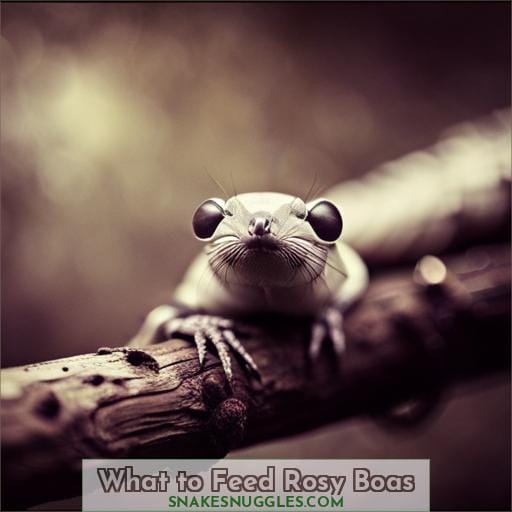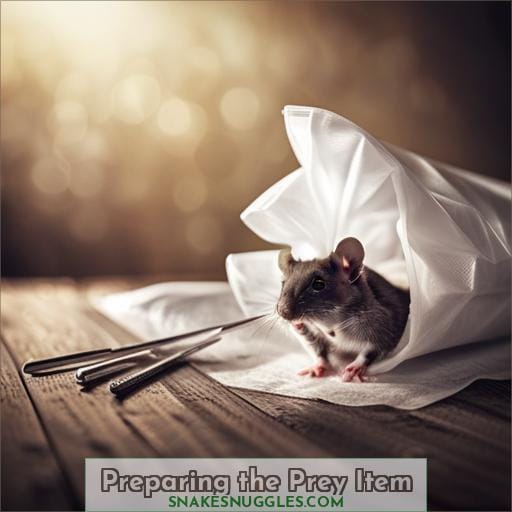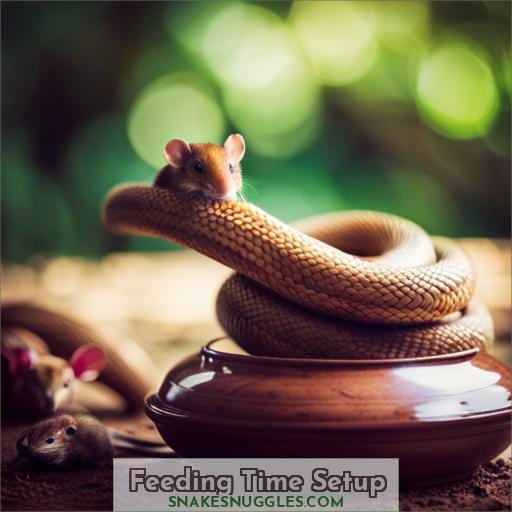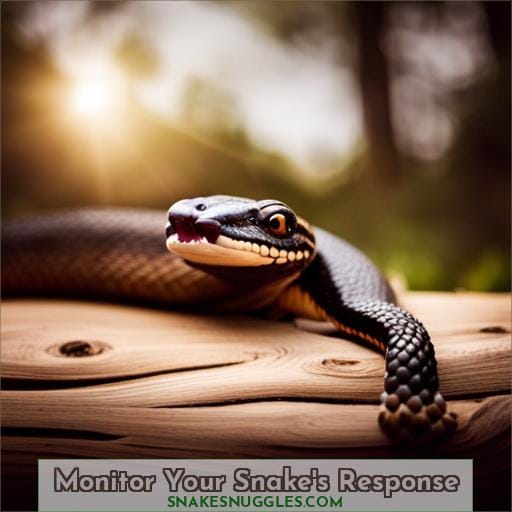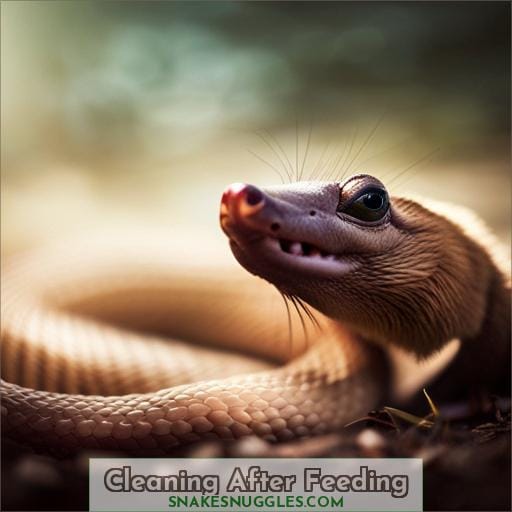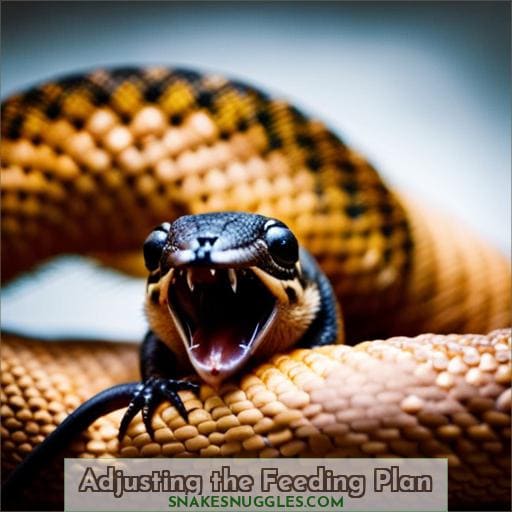This site is supported by our readers. We may earn a commission, at no cost to you, if you purchase through links.
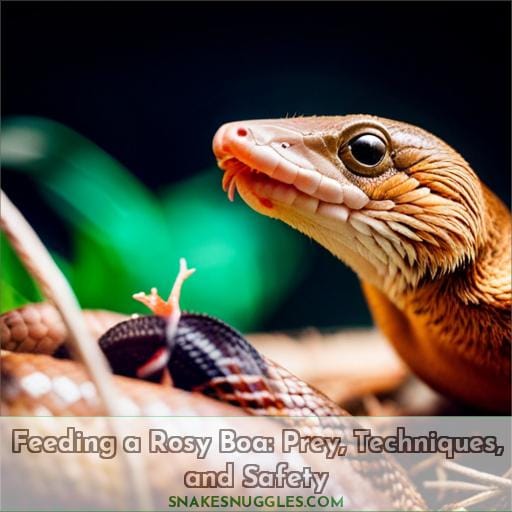 Imagine having the knowledge and confidence to properly feed your rosy boa snake. In this article, you will discover everything you need to know about feeding a rosy boa, including prey types, feeding techniques, and safety precautions.
Imagine having the knowledge and confidence to properly feed your rosy boa snake. In this article, you will discover everything you need to know about feeding a rosy boa, including prey types, feeding techniques, and safety precautions.
From understanding the ideal prey size to mastering the thawing process of frozen food items, we’ve got you covered. Get ready to enhance your reptile care skills and ensure the health and well-being of your beloved rosy boa snake.
Table Of Contents
Key Takeaways
- Choose an appropriately sized tank and provide multiple hide locations for the snake’s comfort.
- Maintain the correct temperature and humidity levels in the enclosure.
- Feed the rosy boa with prey items that are the same width as its body, using both live and frozen/thawed options.
- Monitor the snake’s response during feeding sessions, watch for signs of regurgitation, and adjust the feeding plan as needed.
What to Feed Rosy Boas
When it comes to feeding your Rosy Boa, it’s important to consider the prey size guide and the types of rodents that are suitable.
Prey items should be approximately the same width as the widest point of your snake’s body to ensure proper swallowing and digestion.
For young snakes, starting off with pinky or hopper mice once a week is recommended, while adult boas can be fed adult mice every 7-10 days.
By following these guidelines, you can provide a balanced diet for your Rosy Boa’s health and well-being.
Prey Size Guide
You should always select prey items that are approximately the same width as the widest point of your rosy boa’s body.
To ensure proper feeding, consider factors such as:
- Prey weight
- Prey width
- Prey rigidity
It’s important to choose fresh and properly thawed rodents at an appropriate temperature for safe consumption by your snake.
Also, make sure to match the feeder size with your rosy boa’s age and size for optimal feeding success.
Rodent Types
Prey, Techniques, and Safety:
To ensure proper nutrition for your Rosy Boa, offer:
- Pinky mice
- Fuzzies
- Hoppers
- On occasion rat pups
As adults, feed:
- Adult mice weekly
- Small adult rats if mice seem too small
Always select prey approximately equal to the snake’s width to prevent impaction or regurgitation issues.
Consider quail, chicks, or geckos as alternative rodent options.
Feeding Techniques
When feeding your rosy boa, you’ll need to decide whether to offer live or frozen/thawed prey.
You should also develop an appropriate feeding schedule based on the age and size of your snake.
Striking the right balance between these two factors will promote good health and growth.
Live Vs Frozen/Thawed
Having covered what to feed rosy boas, let’s move on to discussing the techniques for feeding them live vs frozen/thawed prey.
You’ll need to consider the pros and cons of each when deciding the best method for your individual snake.
- Live prey risks exposing snake to parasites and injury.
- Frozen prey lacks stimulation but eliminates disease risk.
- Each method has tradeoffs to weigh for your pet’s health.
Feeding Schedule
How often should you feed your Rosy Boa snake?
The feeding schedule for Rosy Boas depends on their age and growth.
Hatchlings typically start eating after two to four weeks, needing to be fed about twice a week.
As they get older, the frequency decreases, with once a week being adequate for adult snakes.
It’s important to adjust the feeding schedule based on their health, habitat conditions, and prey availability in order to ensure optimal nutrition and overall well-being.
Preparing the Prey Item
Now that you have chosen the appropriate prey item for your rosy boa, it’s important to properly prepare it before feeding.
The thawing process is crucial in order to ensure that the prey is at an ideal temperature and safe for consumption.
Additionally, supplements may need to be added to enhance the nutritional value of the prey item and meet your snake’s dietary needs.
Thawing Process
When thawing frozen prey for your rosy boa, you’ll want to plan ahead and properly defrost the rodent using a sealed bag submerged in cool water to prevent bacteria growth and preserve nutrition.
Avoid thawing in hot water or the microwave, as this can cause uneven heating or cooking that impacts nutrients.
For safety, thaw overnight in the fridge or in a sealed bag placed in a sink of cool water, changing the water every 30 minutes. This keeps bacteria in check while slowly restoring the nutritional quality of the rodent.
Supplements
To ensure your rosy boa receives the necessary nutrients, it’s important to properly prepare the prey item by adding supplements.
Calcium, phosphorus, vitamin D3, and multivitamins are essential for their overall health.
These supplements can be dusted onto the prey before feeding to provide a balanced diet for your snake.
It’s crucial to choose high-quality products that meet the specific needs of your rosy boa.
Feeding Time Setup
When it’s time to feed your rosy boa, first ensure their enclosure is properly set up with hides and adequate heating.
Next, use tongs or forceps to offer the prey item to avoid putting your hands near the snake’s mouth, as bites can occur if they miss the food.
Always supervise during feeding, providing assistance if the prey gets stuck but otherwise avoiding interference.
Enclosure Setup
Once the prey item is properly thawed and supplemented, you’ll need to get your snake’s enclosure ready for feeding time.
- Ensure that the tank size is appropriate for your rosy boa, providing enough space for movement.
- Choose a suitable substrate type such as aspen or cypress shavings that allow burrowing behavior.
- Maintain the temperature range between 65-75°F on the cool side and 80-85°F on the warm side, with a basking area around 90-95°F.
- Keep humidity levels at an average of 40%, increasing to 60-65% during shedding periods if necessary.
- Provide multiple hide locations made of easily sanitized materials like plastic or replaceable cork wood hides annually.
Handling Safety
You’ll want to handle your rosy boa gently yet firmly when moving it for feeding time, taking care to support its body to prevent falls or injury.
Be gentle and avoid sudden movements that may startle the snake.
It’s important not to drop the snake as this could cause harm.
Supporting the body ensures a safe transfer during feeding time setup.
Monitor Your Snake’s Response
When feeding your rosy boa snake, it’s important to monitor their response to the prey.
One common issue that can arise is regurgitation, which occurs when the snake tries to swallow prey that’s too large or when they’re stressed.
If you notice frequent regurgitation, it may be necessary to adjust the size of the food items being offered.
Additionally, pay attention to any changes in your snake’s appetite or behavior during feeding time as this could indicate a potential health issue that needs further evaluation by a reptile veterinarian.
Regurgitation Issues
Regularly monitor your snake’s response after feeding to check for any regurgitation issues. This uncomfortable event has various causes, from incorrect temperatures to overfeeding. Watch for signs like an extended neck, restless behavior, and undigested prey item remnants.
To help prevent regurgitation, carefully manage temperatures, humidity, handling, and prey size.
If it occurs, allow a recovery period of at least 2 weeks before attempting to feed again.
Changing Food Response
To monitor your snake’s response to changing food, observe how they react during feeding sessions.
- Loss of appetite
- Difficulty swallowing
- Regurgitation
Reasons for changing the feeding plan include overfeeding, underfeeding, or natural changes in metabolism as the snake ages. Watch for signs to adjust the amount or timing of feedings up or down accordingly.
Cleaning After Feeding
After your rosy boa has finished eating, it’s important to:
- Remove any uneaten prey from the enclosure to prevent rotting and bacteria growth.
- Sanitize the enclosure to eliminate traces of mouse scent which could stress your snake.
Thoroughly cleaning the enclosure after meals maintains proper hygiene and your snake’s health.
Remove Uneaten Prey
You should remove any uneaten prey within a few hours after feeding time to keep the enclosure clean and prevent harmful bacteria from accumulating.
Wait until the prey is cold before handling it.
Dispose of it in the trash to avoid attracting pests.
After removing the prey, clean the enclosure thoroughly with soap and water to remove any residue or waste.
Finally, sanitize the entire enclosure using bleach to ensure a safe environment for your Rosy Boa.
Sanitize Enclosure
After feeding your rosy boa, it’s important to sanitize the enclosure.
- Remove uneaten prey.
- Thoroughly clean the enclosure with soap and water to eliminate traces of prey scent.
- Disinfect with a 10% bleach solution, allow to dry fully.
- Replace the substrate after each feeding to prevent bacteria growth.
Always wash hands after handling your snake to prevent potential spread of salmonella.
Adjusting the Feeding Plan
As your rosy boa grows, it’s important to adjust their feeding plan accordingly.
Tracking their weight and growth can help determine if they’re getting the right amount of food.
Additionally, as they age, their metabolism may change which could require adjustments in feeding frequency and prey size.
Weight and Growth Tracking
Once you have started feeding your Rosy Boa, it’s important to track its weight and growth to ensure that the feeding plan is appropriate for its development.
Monitoring their weight gain, growth rate, and body condition will help you adjust the feeding schedule accordingly.
Keep an eye out for any sudden changes in growth spurts or unexpected weight loss as these may indicate underlying health issues that need attention.
Changing Metabolism
As your Rosy Boa grows and develops, their metabolism will naturally change, requiring adjustments to their feeding plan.
With age comes changes in metabolism that can affect weight gain and appetite. It’s important to monitor your snake’s health closely during these periods of metabolic adjustment.
Factors such as brumation and seasonal changes can also impact the metabolism of your Rosy Boa, leading to decreased feeding or altered dietary needs.
Frequently Asked Questions (FAQs)
How often should I handle my rosy boa after feeding?
After feeding your rosy boa, you’ll want to avoid handling it for at least 24 hours.
This allows proper digestion and reduces the chances of regurgitation or other issues.
Handling too soon can stress the snake while it’s still metabolizing its meal.
Give your boa a full day before interacting.
My rosy boa regurgitated its last meal. What should I do?
Don’t feed your snake for two weeks.
Make sure temperatures and humidity are optimal in the enclosure to reduce stress.
Offer a smaller prey item when resuming feeding, something the snake can easily swallow.
Go slowly and monitor your pet’s health.
Provide extra hides and limit handling while your snake recovers.
Are there any supplements I should provide with my rosy boa’s diet?
Yes, dust prey items with calcium supplements once a week and multivitamins every 2-3 feedings.
This provides essential nutrients for bone/muscle health and prevents metabolic bone disease.
Vary supplements based on age – juveniles need more calcium, adults need less.
Follow label directions carefully.
Can I feed my rosy boa pre-killed mice instead of live mice?
Yes, you can feed your rosy boa pre-killed mice instead of live ones.
This is a safe and convenient option that eliminates the need for live feeding.
Just make sure to thaw the frozen mice before offering them to your snake.
What type of water dish works best for a rosy boa habitat?
For a rosy boa habitat, it’s best to use a water dish that allows easy access for your snake.
A shallow bowl or dish works well, ensuring that the water is always clean and fresh.
Conclusion
To conclude, feeding a rosy boa snake requires a thorough understanding of prey types, feeding techniques, and safety precautions.
By following the prey size guide and offering appropriate rodent types, you can ensure your snake receives the necessary nutrients.
Whether you choose live or frozen/thawed prey, it’s important to establish a feeding schedule and properly prepare the prey item.
Additionally, monitoring your snake’s response and adjusting the feeding plan accordingly will help maintain its health and well-being.
Remember to clean the enclosure after feeding and track your snake’s weight and growth for optimal care.

